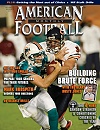Article CategoriesAFM Magazine
|
Mixing in the Gun – Integrating Shotgun into Your Spread Option Offenseby: Nathan M. CochranAsst. Head Coach/Offensive Coordinator, Blackburn College © More from this issue At Lincoln University, we adopted the spread option offense because we felt it gave us the best advantage going into the Mid-American Intercollegiate Athletic Association (MIAA). To complement our spread, we started to run some of our option plays out of the shotgun. We started playing with “the gun” because we have a good center who can shotgun snap the football and block anyone and we wanted to improve our 3-step passing game. It also provided a psychological boost for our athletes who needed more than the monotony of our normal 12-and 13-triple option. In this article I will talk about how we align our backfield to run our base options, what types of adjustments we have to make in our base plays, and some of the wrinkles we were able to incorporate in the offense. All we really did was move the fullb....The full article can only be seen by subscribers.
|
|
|||||||
| HOME |
MAGAZINE |
SUBSCRIBE | ONLINE COLUMNISTS | COACHING VIDEOS |
Copyright 2025, AmericanFootballMonthly.com
All Rights Reserved





